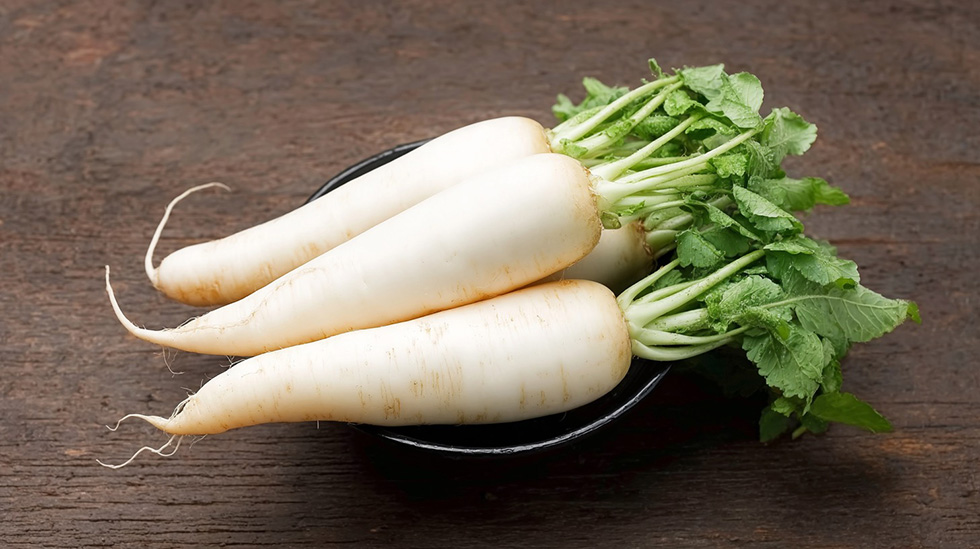Daikon radish – the crunchy, refreshing vegetable that’s more than just a salad topping
Daikon radishes, also known as white radishes, are a real speciality in the world of vegetables. Its Latin name is *Raphanus sativus var. longipinnatus*, and it originates from Asia, especially Japan and China. In Europe, it became known at the end of the 19th century and has been a stable player on the markets ever since, especially in spring and autumn.

How important is it in the kitchen?
4/5
Daikon radishes are a very versatile commodity, but still underrated in Hungarian households. It is excellent raw, cooked or even pickled. It has long been discovered in Eastern and Southern cuisines, but in Europe it is still mainly found in raw salads. Nevertheless, it is available all year round and its flavour adds freshness to any dish.
Which part is edible?
The root is the most valuable and most commonly eaten part of the daikon radish – the elongated, white, crunchy part that is also available in shops. When fresh and tender, the leaves can also be eaten, for example cooked in soup or added to pesto. The older leaves, however, are more bitter and coarser in texture.
Important: radish flowers and fruits are not technically poisonous, but they are not usually eaten. When they are too old, the inside becomes spongy and it is not recommended to eat them, because they taste pungent and their texture can be unpleasant.
Health benefits
Daikon radishes are a real vitamin bomb! Rich in vitamin C, folic acid, potassium and antioxidants. It also has a natural anti-inflammatory effect thanks to the isothiocyanates it contains, supports digestion, helps the liver and bile to function and is an excellent detoxifier. It is also often recommended in traditional medicine for colds, coughs and flus.
Production, season
Daikon radishes are grown both in the open field and in a greenhouse. In Hungary, it typically has two seasons: spring (April-May) and autumn (September-October). The domestic variety is the more tender and tastier. The summer heat does not favour it, as it tends to go to seed easily. In winter, it is typically imported (e.g. from Spain, Italy).
Among Europe’s largest producers, Japan is joined by the Netherlands and France, but it is also widespread in Central Europe, mainly for market production.
How to choose a good quality daikon radish?
It’s not madness, but it’s worth paying attention:
- The fresh radish looks firm, smooth and crack-free.
- Don’t be too soft – old specimens are already stiff and spongy.
- The colour should be snow-white or slightly opalescent – yellowish discolouration indicates a loss of freshness.
- If it still has leaves, they should be bright green, not wilted.
Storage at home
You can store it in the vegetable compartment of the fridge for up to 1 week if you remove the leaves first – they draw moisture from the root. If you want to store it for longer, wrap it in a slightly damp tea towel or paper towel to keep it crisp longer.
International cuisine
- In Japan, it is known as daikon and is used grated, steamed or pickled. It is also a common accompaniment to sushi and tempura.
- In China: it is used to make soup, often with ginger and chicken.
- In Korea: it can be a staple in kimchi, but is also popular as a pickle on its own.
- In France: often eaten with butter and salt as a starter.
Classic recipe: Daikon radish salad Asian style
Ingredients:
- 1 larger daikon radish
- 1 tablespoon rice vinegar
- 1 teaspoon sesame oil
- 1 pinch of sugar
- 1 tablespoon salt
- 1 teaspoon sesame seeds (toasted)
Preparation: peel and grate the radish into thin strips. Mix with the other ingredients and leave to stand for 10 minutes. Make a refreshing, slightly tart salad that goes well with grilled meats.
Kitchen tips, seasoning
The taste of the daikon radish is slightly spicy, crispy and fresh – which is why they go well with it:
- sesame oil
- rice vinegar
- ginger
- lemon
- parsley
- fresh dill
What you should avoid, however, is heavy spices that are too characterful, such as cinnamon, cloves or nutmeg – they can overpower the radish’s natural freshness.
Summary
The daikon radish deserves much more attention than they are currently getting. It’s a healthy, easily available, delicious and versatile vegetable that you can safely incorporate into your daily diet. Its refreshing flavour and ease of use make it the perfect choice if you’re looking to add something new to your plate. 🥗
